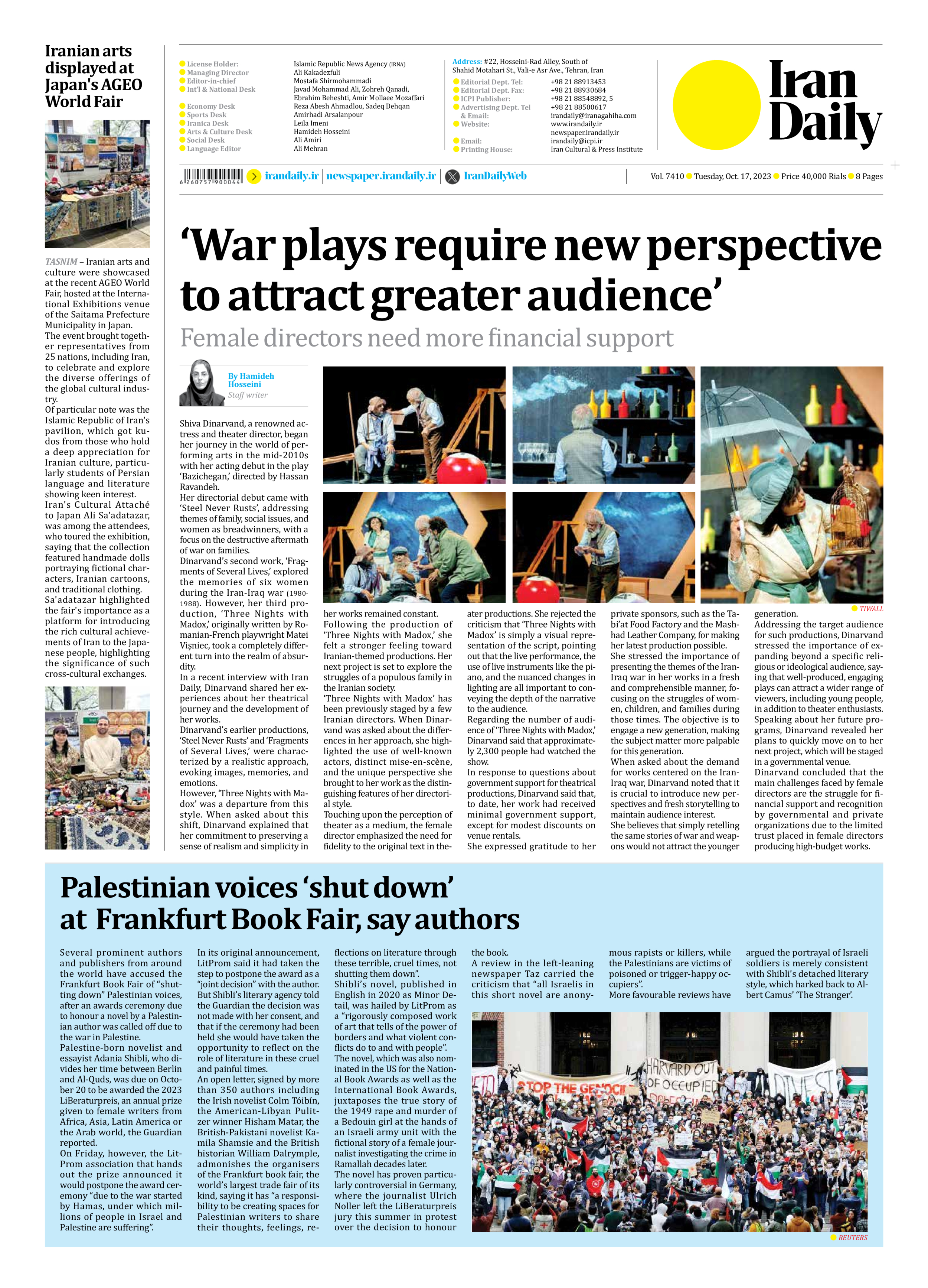
‘War plays require new perspective to attract greater audience’
Female directors need more financial support
By Hamideh Hosseini
Staff writer
Shiva Dinarvand, a renowned actress and theater director, began her journey in the world of performing arts in the mid-2010s with her acting debut in the play ‘Bazichegan,’ directed by Hassan Ravandeh.
Her directorial debut came with ‘Steel Never Rusts’, addressing themes of family, social issues, and women as breadwinners, with a focus on the destructive aftermath of war on families.
Dinarvand’s second work, ‘Fragments of Several Lives,’ explored the memories of six women during the Iran-Iraq war (1980-1988). However, her third production, ‘Three Nights with Madox,’ originally written by Romanian-French playwright Matei Vișniec, took a completely different turn into the realm of absurdity.
In a recent interview with Iran Daily, Dinarvand shared her experiences about her theatrical journey and the development of her works.
Dinarvand’s earlier productions, ‘Steel Never Rusts’ and ‘Fragments of Several Lives,’ were characterized by a realistic approach, evoking images, memories, and emotions.
However, ‘Three Nights with Madox’ was a departure from this style. When asked about this shift, Dinarvand explained that her commitment to preserving a sense of realism and simplicity in her works remained constant.
Following the production of ‘Three Nights with Madox,’ she felt a stronger feeling toward Iranian-themed productions. Her next project is set to explore the struggles of a populous family in the Iranian society.
‘Three Nights with Madox’ has been previously staged by a few Iranian directors. When Dinarvand was asked about the differences in her approach, she highlighted the use of well-known actors, distinct mise-en-scène, and the unique perspective she brought to her work as the distinguishing features of her directorial style.
Touching upon the perception of theater as a medium, the female director emphasized the need for fidelity to the original text in theater productions. She rejected the criticism that ‘Three Nights with Madox’ is simply a visual representation of the script, pointing out that the live performance, the use of live instruments like the piano, and the nuanced changes in lighting are all important to conveying the depth of the narrative to the audience.
Regarding the number of audience of ‘Three Nights with Madox,’ Dinarvand said that approximately 2,300 people had watched the show.
In response to questions about government support for theatrical productions, Dinarvand said that, to date, her work had received minimal government support, except for modest discounts on venue rentals.
She expressed gratitude to her private sponsors, such as the Tabi’at Food Factory and the Mashhad Leather Company, for making her latest production possible.
She stressed the importance of presenting the themes of the Iran-Iraq war in her works in a fresh and comprehensible manner, focusing on the struggles of women, children, and families during those times. The objective is to engage a new generation, making the subject matter more palpable for this generation.
When asked about the demand for works centered on the Iran-Iraq war, Dinarvand noted that it is crucial to introduce new perspectives and fresh storytelling to maintain audience interest.
She believes that simply retelling the same stories of war and weapons would not attract the younger generation.
Addressing the target audience for such productions, Dinarvand stressed the importance of expanding beyond a specific religious or ideological audience, saying that well-produced, engaging plays can attract a wider range of viewers, including young people, in addition to theater enthusiasts.
Speaking about her future programs, Dinarvand revealed her plans to quickly move on to her next project, which will be staged in a governmental venue.
Dinarvand concluded that the main challenges faced by female directors are the struggle for financial support and recognition by governmental and private organizations due to the limited trust placed in female directors producing high-budget works.







